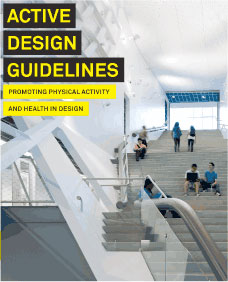NYC Agencies Team Up on Guidelines for an Active City
 City officials, architects, planners, and public health advocates crammed into the Center for Architecture last night for the unveiling of New York City’s Active Design Guidelines.
City officials, architects, planners, and public health advocates crammed into the Center for Architecture last night for the unveiling of New York City’s Active Design Guidelines.
Heralded as a first-of-its-kind collaboration between four city departments — Health, Transportation, Design and Construction, and City Planning — the effort underscores that New Yorkers, as much as we like to think of ourselves as a city of walkers, need to live healthier lifestyles.
The statistics touched on last night (included in the manual’s opening chapter), reveal that the majority of adults in New York City are either overweight or obese. More alarming, perhaps, is that 43 percent of elementary school children are overweight, and the rate is rising.
As sobering as those numbers are, Health Commissioner Thomas Farley stressed that the city’s effort "is not just about lowering obesity rates, but also about addressing diabetes, cancer, osteoporosis, depression, and cognitive decline.” Such chronic diseases, he stated, are exacerbated by how we currently design the built environment and may be quelled with even the most moderate amounts of exercise, whether it be from walking, bicycling, or even climbing the stairs.
To this end, livable streets activists will find much to applaud in the pages of the Active Design Guidelines. Inside, many elements of the city’s new Street Design Manual are further substantiated with research indicating that safer streets will translate to a markedly healthier city. From mixing land uses to — yes — addressing the supply and location of parking, the guidelines focus on the role urban design should play in making New York City a healthier place to live.
While this is a far-reaching and impressive document that other cities should seek to emulate, it is, in the end, only guidelines. The hard part, as always, is executing the wisest policies and enacting the right recommendations.

